Steps I and II selected the site for the MIS and gathered background information needed to customize the MIS for a particular locale. Now, in Step III, that information will be used in discussions with the MIS users to design the system that will be most appropriate for their needs and resources. There are eight parts in the design of the MIS. In each part, the users must decide how they want to organize the MIS. The facilitator's role at this stage is just that: to facilitate. It is a matter of helping the community review its options for each part and of ensuring that all the information that could contribute to making a good decision has been considered. The facilitator may be able to provide information from previous experiences to help the users come to a decision, but s/he should not be the one to make the design decisions. It is essential that the users assume that responsibility so they feel that the MIS is their own. Special care should be taken at this stage to avoid imposing the facilitator's notion of a "standard" MIS on the community.
In Step III, the users will:
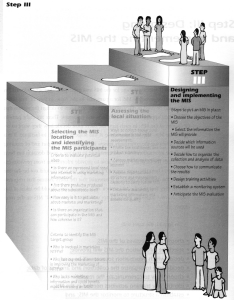
In this section, each of these parts is addressed in turn, pointing out how the information collected in Step II should be used in the design decisions that need to be made in Step III. These parts follow an approximate order that will make sense for most users, but need not be followed strictly if another sequence makes more sense. Sometimes they are automatically combined. For example, if there is only one place to get the information, a decision about what data will be gathered will automatically determine the source to be used. In Uganda, once the decision was made to gather information on buyer preferences, the primary information source was clear - buyers themselves. The group still had to decide, however, how many people it would contact and how it would get the information.
As decisions are made in each step of the MIS design, special attention needs to be paid to the scope and complexity of the undertaking. Wherever possible, in the initial stages of the MIS it is best to reduce and simplify as much as possible, focusing on the most essential elements. A small, simple system that works well can always be expanded later. It is much more difficult to salvage a complicated system that has fallen apart.
The initial enthusiasm for a new venture, which is sometimes fueled by the facilitator's vision and expectations, may lead people to overestimate the time and resources they can devote to implementing the MIS. A participant may eagerly offer to monitor prices at seven market stalls each Friday, but will she be able to meet this commitment week after week given all the other demands on her time?
There are no standard guidelines for the optimal cost, number of participants, and scope of an MIS because this will vary greatly. However, participants should be aware that the constraints that most often sabotage the success of such a venture are people's time, the monetary costs of implementing the system and the capacity to manage the activities of the MIS. Users should be encouraged to address these issues frankly with one another and to be as realistic as possible about constraints that they face as individuals and as a group. They should also be prepared to reconsider decisions they make in the design phase as implementation gets under way since it is often difficult to predict in advance how things will work out in practice.
The goal of any MIS is to increase market transparency so that the producer will have the information to make informed sales decisions and to increase market leverage. The objectives focus the MIS on specific products and pieces of marketing information. The users will need to decide whether their MIS will focus on increasing the price they receive for their products, whether they are seeking to expand the number of markets they use, whether they want to change the kind of good they produce so that it sells more quickly, etc.
The information needed to narrow the objectives of the MIS was collected in Step II. It is likely that many possible objectives surfaced during discussions. In any enterprise, there are multiple avenues for improving profitability. The task at this point is to prioritize the possibilities and to focus on those that are likely to generate the highest returns for the users. As a starting point, identify several areas in which local businesses might be improved and then consider how readily information is available to increase the transparency of this part of the business. Specifically, the facilitator may want to orient the discussion of objectives around four key questions.
1. What are the principal problems users face in their NTFP enterprises?
2. What do they need to know to overcome these problems?
3. What kind of information can be most readily accessed by users?
4. What kind of information can users use in their business decision-making?
Questions 1 and 2 can best be addressed using the marketing chain diagrams that were prepared during the assessment step. As users compare the marketing chains (see Figure 3) for different products and examine each marketing chain individually, they will begin to identify the bottlenecks and constraints that are causing difficulties.
Figure 3: Uganda marketing chain
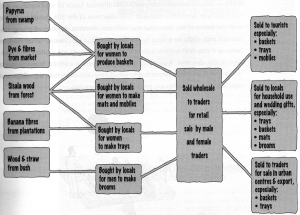
Once these problems are identified, the users can list the kind of information they will need (question 2) to find solutions. This might include: better information on product demand or purchasers' preferences; insight into what truckers do with the products and how much profit they earn; and price levels for goods sold in area markets and transportation options for reaching those markets.
Question 3 then asks to assess the difficulty of obtaining the information identified as potentially useful. Some information might be useful but would require too much work to collect and analyse. In the example above, it might be quite easy to conduct a survey of buyers' preferences among people who pass by on the road. It might be considerably more difficult to gather information from further markets if the cost and time of transport are real constraints.
Question 4 simply asks the users to be realistic about what information they will use. People operate enterprises with different levels of sophistication and have different personal constraints. The objectives of the MIS should be in line with the nature of the enterprise and the users' situation. A group of young, unmarried men might be willing to put the extra effort into visiting far-off markets because if they find ways to improve their profits, they could reorient their business in that direction. A group of mothers involved in a similar business might decide that it is entirely impractical to spend long days away from the village and conclude that there is no use even exploring that option.
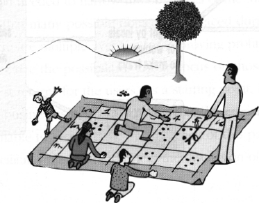
In light of the discussion of these four questions, the users should prioritize their objectives, focusing on the option that is likely to give them the best return for their investment of time and resources. It is often useful to compile a list of advantages and disadvantages for each option being considered. One way to facilitate a discussion that prioritizes people's interests is to list all the options on a piece of paper. Collect a pile of stones, and ask the group to prioritize the options by putting more stones next to the ones that they consider more viable and fewer stones next to those that are lesser priorities. As they place the stones, people will explain why they think one idea is better than another. At this point, they are deciding how they will focus the initial activities of their MIS. At a later time, they may be able to expand their objectives to cover other products or other problems they have identified.
In one Philippine village, participants initially wanted to investigate the entire production and sale chain for each of their agroforestry products. They soon realized that such an undertaking would be far too vast and complicated for the resources they had available. They decided instead to focus on monitoring prices in local markets for a more limited range of products. They felt that they could always move further into the marketing chain as the assessment progressed.
The participants set criteria for determining which products would be included in the MIS study. They decided to include a product only if (1) it were already being produced locally, (2) people felt that they had significant marketing problems with that good, and (3) the product could be measured and quantified easily, so it would be possible to collect comparable price data without too much difficulty. The goods that met these criteria and were selected for further study were: whole coconuts, black pepper, ginger, cassava, two varieties of bananas and eggplant.
Immediately following the assessment phase, the facilitator requested the population to review the results of the assessment and to decide how they felt their businesses could be best improved. They did this in his absence. Upon his return they told him that they thought the purpose of the MIS should be to increase sales and the number of markets for handicrafts that were being produced in the area.
He then asked them to think about what information they needed to improve the marketing of handicrafts. After some reflection, they decided that if they knew more about consumer preferences, perhaps they could target the demand more effectively.
They decided to focus on three of the principal handicraft items produced in the area: mats, stools and baskets. They then thought of all the characteristics of these products that might affect consumer preferences. The list was long, but eventually they decided to limit their inquiry to four questions, asking consumers about their preferences concerning (1) size, (2) colours, (3) weaving patterns, and (4) the type of raw material used.
Once the users are clear on the purpose of the MIS and have decided more specifically what kind of information they want to gather, the next task is to organize the collection of the data and decide how it will be analysed.
This involves decisions about who will collect the data, where it will be collected, how it will be recorded, and what will be done with it once it is gathered. Two key considerations are that the system provide information that is both accurate and timely and that it not pose too great a burden on the people who volunteer their time as data collectors.
In designing the data collection system, four questions need to be answered.
1. What data are needed and how often does it have to be collected?
2. Where are data to be collected?
3. Who is available to collect the data?
4. When do users need to have the information?
The first question can be answered in part by the work that was already done in establishing objectives (Step 1). This will have clarified whether the MIS is looking at prices, consumer preferences, transport options, etc. How often information is collected depends in part on how variable the information is. Prices for certain perishable products may change almost daily depending on a host of supply and demand factors. It will be necessary to gather information on prices for this type of good much more often than for a non-perishable good that has a fairly stable price. Other information, such as the costs of transport options, may change only a few times a year depending on the season.
The data collection system will be designed in part around how difficult it is to access the sites where data are available (question 2). The system design depends on whether all the information can be gathered in a local market that is widely frequented by the MIS participants or whether it is necessary to send people farther away to gather information. In the first case, many people may participate by each gathering prices for one or two items from one or two sellers. If the market is farther away, it may make more sense to send just one person to gather all the information but take turns making the trip so that the burden does not fall too heavily on any one person.
Question 3 assesses the interest and willingness of MIS participants to contribute their time to gather data that will be used by the group or the community at large. It is also important to have information on collectors' schedules and alternative activities so that the data collection system meshes well with their time constraints. The more convenient the system is, the more likely that people will continue to participate.
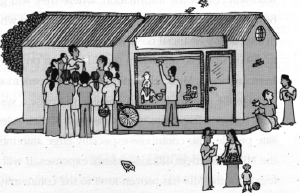
In selecting data collectors, knowledge, enthusiasm and reliability will be key considerations. The MIS operators should be people who intend to use the information since they are most likely to feel a personal investment in making the system work properly. Certain people may be "natural" choices as data collectors. If a price information system is being created to gather data from different market places, data collectors should be chosen wherever possible from among people who already frequent those markets. If this can be arranged, the costs of gathering information will be minimized, and the collector may already know people that s/he can use as sources of information.
If it becomes clear in the design stage that the demand for information is higher than the willingness of participants to contribute to its collection, it will be necessary to reconsider some of the earlier decisions concerning the type and amount of information to be gathered. In such cases, it may be necessary to scale down the objectives from those that were initially established.
Finally, in designing the system, think about when the information is needed. If participants always market their products on Saturday, they will need to have information about the prices being paid in area markets by early Friday so they can plan their activities accordingly.
Once all this information is in hand, the system can be designed to be as appropriate as possible to local needs and resources. The design should specify who will collect the information, where they will go to get it, when they will bring it back, what they should do with it and to whom to report in case of difficulty. If any financial costs are involved (such as paying fares to collect prices in distant markets) the design should be clear on how people will be reimbursed. In many cases, MISs rely entirely on volunteers to collect the information and manage the system. It is also possible to devise a system in which members pay dues (either a fixed sum or a percentage of their sales) that are used to compensate people who contribute especially large amounts of time to the activities of the MIS or to cover other necessary expenses. It will often be possible to collect fees once the MIS has proven itself to the community.
In a Philippines village, participants decided to monitor prices for six different products (see previous Philippines text box): coconuts, pepper, ginger, cassava, bananas and eggplant. Now they had to decide where they would gather the information. They considered a large number of possible sites, but eventually ruled out many of them because of the costs involved in travelling to get the information. They settled on five markets: a roadside market in the village, the local community market and three markets in different nearby cities. They also decided to monitor radio and television reports to get an idea of how local prices compared with the national finures.
Ten people volunteered to serve as data collectors. They were divided into teams of two, with each team responsible for one of the markets that would be visited. In most cases, the volunteer already had activities in the market to which she was assigned.
Each data collector visited the assigned market once a week and gathered price information from five different traders. They were expected to turn in their price information to the record keeper no later than Saturday morning so that price information could be updated, compiled, and posted before farmers went to the weekly markets to sell their products on Sunday.
The data collectors had a form they used to record the information (see Appendix 4 for a copy of the data collection sheets). Because the data collectors reported some suspicion among the people they contacted for information, it was decided that they should wear special vests that identified their function. Once their role was carefully explained to the traders and they wore the vests that were provided them, they encountered fewer difficulties in their data collection activities.
In Uganda, the MIS activities were focused on consumer preferences, rather than prices. The participants devised a system to collect information on the kinds of goods that were sold in different handicraft stores/markets. They asked the clerk who sold the goods to fill out a short form for each item sold. The form (see Appendix 4) had spaces to note down what was sold and its characteristics (size, colour, and material). The data collectors collected the forms on a regular basis and submitted them to the MIS Secretary who kept them until they were analysed at the end of the month.
In addition to using the forms, data collectors were to survey customers' preferences. At first the data collectors were reticent to bother the customers. They soon found, however, that people didn't mind answering the questions and this proved to be another useful source of information. Direct interviews with consumers were particularly useful in getting information on potential new product lines (what people might be interested in buying in the future) since this information could not be obtained from the actual sales data.
Once the data have been collected, it is essential to have a record-keeping system that can keep track of the information and ensure that it does not become lost or confused. Record-keeping and analysis are closely related. Sometimes this is referred to as turning "data" into "information. " "Data" are the rows and rows of raw numbers that are turned in by the data collectors. "Information" results when these numbers are organized, compiled and presented in a way that is useful to the MIS participants.
Record-keeping starts with the data collectors, as noted in the preceding section. It is generally easiest if the data collectors record the information on forms that they then give to the record-keeper. It is also possible for each data collector to keep a notebook in which s/he jots down the prices. The data collector then submits the notebook to the record-keeper who will transfer the prices to his or her own notebook and return the original to the data collector. It is important that the data collectors keep neat records so that it is clear what each number means. The worth of the whole MIS depends on the accuracy of the information that is gathered and recorded by the data collectors.
The next task is for the record-keeper to record all the information that has been collected from the different data collectors. The system will depend on the kind of information that is being gathered, the number of products that are being followed and the number of markets visited. It may make sense, for example. for the record-keeper to have a separate notebook for each product so that all the information about mangoes is in one book and all the information about bananas is in another. The record-keeper should be sure to record all the information available: the date the data were collected, where it was collected and what information was obtained.
At this stage, the record-keeper may find it useful to begin summarizing the data in a way that will be more user-friendly. This is really the start of analysis. In the Philippines case, for example, each week more than 300 prices were collected (six products in five markets, with 10 sellers in each market). Instead of recording all 300 prices, which would be unwieldy and not terribly useful, the record-keeper might average each good in each market. In a given market s/he will be presented with 10 prices for coconut. One way to summarize the price for that market would be to eliminate the highest and lowest price, and then average the remaining eight prices (add them all and divide by eight). S/he would do the same for coconut prices in the other four markets. In this way, MIS users would be able to compare the average price for coconut in each of the five markets (see Table 1).
Table 1: Price of coconuts in five markets March 20, 1993
MARKET A |
MARKET B |
MARKET C |
MARKET 0 |
MARKET E | |
seller 1 |
3.00 |
3.50 |
3.00 |
3.00 |
3.50 |
seller 2 |
|
3.50 |
3.00 |
|
3.50 |
seller 3 |
3.00 |
3.70 |
3.20 |
3.10 |
|
seller 4 |
3.00 |
3.20 |
3.20 |
3.20 |
3.50 |
seller 5 |
3.00 |
3.20 |
320 |
3.10 |
3.40 |
seller 6 |
|
3.20 |
3.20 |
|
3.40 |
seller 7 |
3.00 |
|
|
3.20 |
3.50 |
seller 8 |
3.00 |
3.50 |
3.00 |
3.20 |
|
seller 9 |
3.90 |
3.50 |
|
3.20 |
3.40 |
seller 10 |
3.10 |
|
3.00 |
3.10 |
3.50 |
Average price in market |
24.1 ÷ 8 = 3.01 |
27.3 ÷ 8 = 3.41 |
24.8 ÷ 8 = 3.10 |
25.2 ÷ 8 = 3.15 |
24.7 ÷ 8 = 3.46 |
Once the data have been recorded, some thought needs to be given to the best way to present it. In some cases, a table with neatly labelled columns and rows may be the fastest way to present the information. It is also a good approach when space is limited. Sometimes rows and rows of numbers can be confusing, however. Data can also be presented with visual diagrams, such as bar graphs and trend lines, which make the meanings of the numbers more clear. Bar graphs are generally used to compare two kinds of information. They could be used, for example, to show how prices for coconut vary in different markets. In this case, prices are put on the vertical axis of the graph (see Figure 4), and the different markets are on the horizontal axis. By looking at the height of the block, it is easy to see which market has the best price for a given item.
Figure 4: Bar graph showing price of coconuts in five markets March 20, 1993
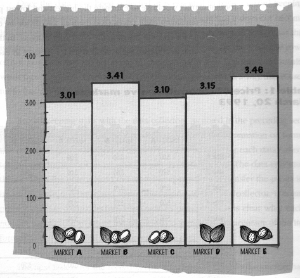
Trend lines (see Figure 5) show how things (like price or quantity sold) change over time. In this case, time is put on the horizontal axis and the variable that changes (price or quantity sold) is put on the vertical axis.
Figure 5: Trend line for price of coconuts in market A (1993)
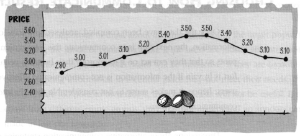
It is up to the MIS participants to decide how it will organize to analyse the collected data. Some may want to meet weekly or monthly to review the data as a group and determine how it can be presented and used in an interesting way. In other cases, they may want to delegate one or more members of the group to compile the information and then post it for others to use.
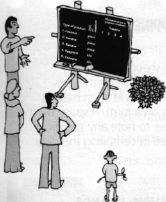
Information that has been recorded and collected should always be stored somewhere safe. Data about prices should not be thrown out the week after it is used, for example, because at some later point the MIS may need to look at how prices have changed. The old data will prove very useful in such a case.
In the Philippines, the data collectors submitted their sheets by Saturday morning to the record-keeper. The record-keeper, as described in the text, would average the prices that were collected for the goods in each market. She would then, in turn, record these average prices on a form. A space on the bottom of the dated recording sheets left room for her to note any specific comments from the data collectors or issues she noted in compiling the data.
The data collectors visited each of the roadside handicraft stands that were recording sales information and brought the completed forms to the secretary. At the end of the month, the secretary tabulated the information on each month's sales for each shop or sales outlet (see Appendix 4). This information was then presented in bar charts to show the volume of sales for products with different characteristics. Using these visual aids, the MIS members held a meeting at the end of each month to discuss the findings and the implications for their business ventures.
Once the data have been compiled, analysed and transformed into useable information, the next step is to communicate this information to the MIS participants so that they can act on it to improve their business ventures. The whole effort is in vain if the information is not communicated effectively to the potential users; hence, it makes sense to put considerable thought into the design of the communication system.
Discussions about alternative communication strategies should focus on at least four questions.
1. Who is the MIS targeting with information?
2. What kind of information will be transmitted?
3. When is the information needed?
4. What communications options are available?
The first of these questions, identification of the MIS constituency, is often the most controversial. It is here that the decision must he made about whether the system will be inclusive, which allows any interested person access to information, or whether it will be exclusive, limiting information to members of a particular group. This is an important factor in choosing how information will be communicated since some types of communication (radio, public notice boards) are more inclusive while others (private meetings, word of mouth between members, notice boards in private areas) are more exclusive.
There are often good reasons for favouring either an exclusive or an inclusive MIS; neither option is inherently more appropriate than the other. While an exclusive system can help equalize the balance of power in a trading system, it also can antagonize those involved in trading who do not have access to the information. In deciding with whom to share information, it is important to assess whether the benefits of limited access to information would be worth the risk of antagonizing another, more powerful trading player. In the Philippines, for example, when traders felt threatened by the information, they erased data and spread rumours about the data's unreliability. The possibility of this type of reaction needs to be considered when deciding which type of MIS is more appropriate.
It is also important to think about the characteristics of the target population in selecting the mode of communication. If the users are mostly illiterate, posting a table of numbers on a bulletin board will be ineffective. If they are broadly dispersed, posting information in a central place may not meet their needs. If the MIS users are too poor to own radios, then broadcasts will not he useful. If they come from different ethnic groups, they may not understand an announcement made in just one language.
The second issue concerns the type of information to be transmitted. If the information is very simple, communications strategies will be different than if the information is more complicated. If there are only three prices to be transmitted (say for mangoes in three different markets) then it may he enough to rely on word of mouth among the members. If there are many prices to be communicated for many different goods, then a more formal presentation of the information may make more sense. The more complicated the information, the more important it is to use clear visual aids that will help people understand the message being conveyed. (Some possible methods for visual presentation of information were covered in the preceding section.)
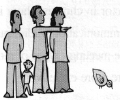
Question 3 asks the group to think about when the information is needed, as this will also affect the way it is communicated. If the information is required on a weekly basis for marketing purposes, it is important for users to receive it on time without having to spend too much time getting the information. A notice board in a public place or a short announcement on a local radio programme might be effective in this case. If information is to be used to diversify product lines, it may not need to be communicated as often, but it may require more discussion and explanation. A meeting, once a month or once every two months, would be a better way to communicate this kind of information.
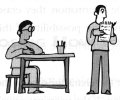
Question 4 reviews the information gathered in the assessment step on possible communications methods.
There are many options, and it is unlikely that all will be found in any given community. There are technological ways of communicating, such as radio and television broadcasts, as well as more local methods such as posting information on blackboards, making announcements at religious gatherings and passing information through local farmers' or women's organizations. The possibility of using informal communications channels, such as women passing information among themselves at a central gathering place, should not be overlooked.
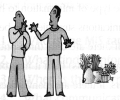
As with all the other parts of the MIS, decisions about communications systems should be made only after considering the resources available to the group and whether the expected returns warrant investing resources in the system. It is best to start out modestly, increasing the scope of the endeavour only after it proves its utility. Some forms of communication may be very expensive (buying radio time, for example). If the benefits of having the additional information provided by the radio broadcasts are only marginal to the MIS group, it may not be worth investing in this form of communication. Perhaps there could be similar benefits from using a less expensive form of communication such as a community bulletin board.
In some cases, members may even be willing to pay (in the form of dues to the MIS group) for the services they receive since they know that they earn higher profits because of them. This money could be used to pay for radio time, if that is felt to be the most effective way of communicating. Realistically, however, it is often difficult to predict what the level of benefits will be for MIS participants. This is another reason to start slowly and modestly, building the complexity and sophistication of the MIS in relation to the benefits it provides.
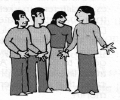
MIS users are often tempted to create new communications channels such as printed leaflets or newsletters that are devoted to information about the MIS. Groups sense that this will give them a feeling of pride and accomplishment. While this sense of ownership is important, establishing new communication mechanism should be done with great caution. They often prove to be time-consuming and expensive. It is generally better to start by using existing communication channels. New systems should only be put in place when existing systems are found to be inadequate. Even then, new communications networks should be attempted once the MIS is well under way, has proven its usefulness, and the users are confident that the information it generates is accurate and valuable enough to justify the cost involved in establishing the new communications network.
There are always difficult trade offs in setting up communications systems. In one area of Peru where an MIS was set up, the only transportation between communities was by river. Farmers using the system were dispersed in a large forested region and only rarely travelled to the city. Instead, traders in motorboats visited the outlying villages to exchange wares. The people designing the MIS found that communications posed a particular challenge in this setting. Eventually, they decided to purchase radio time that could reach 300 000 local farmers with price information from the urban centre. This was an effective way of getting the information out to large numbers of dispersed people, but it was a costly solution. The project paid for radio time at the beginning, but it was not certain that this system could be sustained, particularly when project funds were withdrawn.
In the Philippines, the MIS group decided that the most effective way to communicate information was with centrally-placed blackboards. Initially, one blackboard was painted with the names of the products and the markets where prices were being monitored. When the record-keeper received the prices from the data collectors, he calculated an average price for each good in each market and then entered the information in the appropriate space on the blackboard.
By the second month of operation, farmers from outlying areas had learned of the system. They requested that a second blackboard be placed where they could see it on their way to the market since they did not regularly pass through the center of the village. With the cooperation of one of the village elected officials, this second blackboard was installed.
As people gained interest in the price information, demand grew for additional notice boards so that users would not have to go so far to get the information. Several corkboards were installed in places where people congregated. The local FAO project staff agreed to provide weekly price summary sheets from the information provided by the record-keeper. These were posted on the corkboards.
The record-keeper also drew trend lines to show how prices had changed in the different markets during the year. While this was of only modest interest in the first year, by the second year users could begin to use the trend lines to predict price changes in different markets and to adapt their marketing strategy accordingly. During the April evaluation, for example, one woman said that she had ginger ready for harvesting but was going to wait until August since the trend line from the previous year indicated that prices were higher in that month.
Choosing the method for communicating results proved to be highly controversial in the Ugandan villages where MISS were tested. Both communities had problems with the question of sharing information with the whole village or limiting it to people in the MIS group. In one village the participants decided to post the results publicly. In the end, however, the board was never put up. Instead results were discussed privately within the group.
In the other village, the group decided to post results as well as share the information in monthly meetings of their group. While some people were initially reluctant to publicize the information on the community bulletin board, they eventually decided that this was a sound strategy because store owners were much more willing to participate in the data collection exercise if the information were made available to whomever was interested. They found that they could obtain better and more complete information if they were willing to post it in a public place.
At this point in the design process of the MIS, the essential questions concerning the operation of the system have been answered. The users have (1) defined their needs, (2) proposed a system to collect and analyse the information they need, and (3) considered the most effective ways to communicate that information to people in the community. The next part of the process is to determine what training people need in order to make the system work and to use the information to improve their businesses.
To make the system effective, it is critical to adapt training to the needs and capacities of the operators and users of the MIS. Without such training, there is great danger that poor quality data will be collected (which risks jeopardizing the credibility of the system), that the data will not be correctly analysed (which reduces its usefulness), or that users will not understand how to exploit the information generated by the system (which wastes the time and efforts of participants).
In planning training activities, there are three key questions.
In determining the training programme, the first question is exactly what kind of training is needed to make the MIS functional. This will vary greatly depending on the complexity of the MIS and what people in the community already know how to do. Many meeting and decision-making skills will have been acquired in the process of designing the MIS. The best way to focus this question and to be sure that no major components are overlooked probably will be to review, one by one, each of the MIS activities that have been proposed in the previous design steps. Begin by thinking about how the MIS will be structured. Is there an association that will manage the system, or an individual? In some communities, people have ample experience with committees and group activities. In others, where there is less experience, basic training in such skills as managing meetings and making decisions in a group may be needed.
Next review the data collection procedures that are to be put in place. There is almost certainly going to be some training required at this stage, even if it is only to standardize the terms and procedures that are used, to ensure that comparable data are collected by all the participants. Training may, similarly, be required for the record-keeper(s). It is also likely that at least some training will be required to teach people how to average figures or how to analyse data. This task may be more or less complex depending on the system that is put in place. In some communities, people will need help in putting information into bar graph form; in others they will know how to do this already. Instead, they may need help in some more complicated calculations, such as determining the "break-even point" so that the selling price covers all the costs of production.
If the communications system does not resemble something already being practised in the community, some training also may be required at this stage. This might involve showing people how to prepare effective visual presentations of information, or training them in how to prepare clear information for transmission on the radio.
Finally, what skills do people need to use the MIS information to improve their business activities? This may involve training in financial analysis such as determining which transport option offers the most advantages given the price of transport, the size of the vehicle and the selling price of the good to be transported in various markets. Or, it might demand training in a certain handicraft activity if the MIS determines that people could earn more money by producing, for example, baskets instead of mats. Some training needs may not be evident until after the MIS gets under way. Design of training activities will continue throughout the implementation of the MIS.
As each training need is identified, the number of people who will need training and their characteristics should be noted. In order to increase the probability of sustainability, most MISs should start as a small system, perhaps 10 to 20 participants. The number of people involved will help determine the kind of training that will be appropriate.
The characteristics of the people to be trained will also be important in designing the most effective training. Are they literate? What kind of schedules do they have and when do they have time to participate in training? What language do they speak? Are they more comfortable in single or mixed gender groups? What kind of educational/training background do they have?
If people are to participate fully, it is critical that training activities are scheduled at a convenient time for the participants. This will determine the best season for the training (when people are not too occupied in the fields, for example) as well as the optimal time of day. It will also be a factor in deciding whether the training should take place over several days, a few hours at a time, or be concentrated in one or two longer sessions. Similarly, if people are to absorb the information, the training must take into account their educational backgrounds and their social and cultural needs. Because the turnover of MIS operators may be great, it is important to create an approach to training that will allow relatively easy training of new recruits.
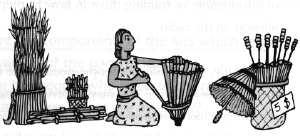
Information that was gathered in the assessment step about the characteristics of the community and how it is organized will also be useful in designing training programmes. There may be organizations already in place, for example, that have the confidence of the local population and would be effective sponsors for community training activities. These or other organizations could also spread the word among their members about training opportunities.
The next task in designing training is to review what training resources are available. Some information was gathered in the assessment step; as the training needs become clearer, people may come up with new ideas about possible training resources. Training may take many forms, and the list of training resources should be as inclusive as possible. It may include formal training situations, such as using university instructors and extension workers to prepare short courses, but it also may include less formal learning situations, such as visits to other villages which have had interesting marketing experiences.
Once all of these questions have been considered, a training plan can be put together. If the training needs that have been identified seem overwhelming, it may mean that the proposed MIS is too ambitious given the characteristics of the community. This may suggest that some revision of the objectives and activities is called for, at least to get started. The training plan should begin with those needs that are essential to getting the MIS under way. As time goes on and interest in the system grows, additional training activities can always be added.
It is impossible to propose any specific recommendations for training that would be applicable to all the different kinds of MISS and communities that will use them. However, two general recommendations are broadly applicable.
Training activities should be as practical, applied and hands-on as posh Bible. If training is to be provided in data collection, at least some part of the experience should involve visits to markets to collect data. If people are to learn financial skills, they should bring information about their own NTFP activities and practise applying what they learn by analysing those activities.
When possible, people who have experience with an MIS and have backgrounds similar to the trainees should be used as trainers. Experience suggests that often the most effective trainers are not academics, but peers who are able to establish a rapport with the people being trained.
Village women who have begun using an MIS in their own activities may be the best trainers for women from a second village who are about to begin collecting data. The village shopkeeper who has been doing effective record-keeping may be the best model for the person who will take that role in the MIS. As one participant from the Philippines noted, "it is easier for a farmer to learn from another farmer. " Teaching others also reinforces and develops the trainers' skills and promotes greater self-confidence.
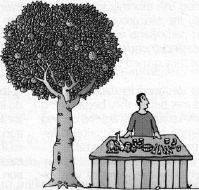
The initial training requirements for operators were kept to a minimum in the Philippines by selecting data collectors who already had some knowledge of markets and marketing. These volunteers helped design the information collection forms and therefore had no problems using them. As additional people volunteered, they received an orientation from the experienced data collectors, and the record-keeper explained how to use the data collection sheets.
Discussions in monthly meetings were used as informal training opportunities. The facilitator asked the data collectors why they thought prices had changed over the previous month and helped them understand the reasons that prices might change. She also brought publications related to marketing for MIS operators and users.
In retrospect, it is clear that the need to train the users of the MIS information was underestimated. There was no formal training of users at the beginning and some misunderstandings occurred as a result. Some users, for example, complained that the prices on the board were lower than those in the market. They did not understand that the prices on the board were the prices the trader would pay for the goods (the wholesale price), which were lower than the prices in the market (the retail price).
As the MIS continued, participants identified new areas where training would be useful. Many people expressed an interest in learning methods for calculating the costs of production. They knew of one farmer in the area who already did such calculations. The group organized a training session in which the farmer, along with the facilitator, taught different approaches to calculating costs and determining profits.
In the first Philippine MIS site, most of the training was done by the facilitator. But, as new sites were developed, they were able to learn from the experiences of the first village. Data collectors and analysts from Sta. Catalina (the first site) travelled to the new villages to discuss the role of the data collector, describe some of the lessons they had learned and offer helpful hints for approaching traders. They did role playing to illustrate different experiences the data collectors had with traders and then discussed the scenarios.
In Uganda, most of the training took place during the monthly meetings organized by the MIS group. The facilitator helped participants with each activity, encouraging them to take more of the lead as they gained experience.
The group designed its data collection forms and met before they began using them, to make sure they agreed on and used common terms to describe different objects and their characteristics.
While eventually the secretary was expected to be in charge of data analysis, initially it was done as a group so that everyone could learn the procedure. The facilitator showed people how to compile the data sheets and took the lead in actually processing the numbers during the first few months. Over time, the secretary took on more responsibility for this task until eventually she could do it herself. At the meetings, the facilitator led a discussion about the information that had been gathered that month so that users could begin to get a better idea of the usefulness of the information and how it could be applied to their businesses.
At this point in the design process, a community has all the elements in place for a successful MIS. However, there are still two more systems to be put in place: a mechanism for monitoring the MIS on an ongoing basis and a plan for periodic evaluation of the programme.
It is nearly impossible to design an MIS that can be implemented without problems. There are always unexpected factors to be taken into consideration as the activity progresses. The purpose of the monitoring is to catch problems as they arise and adapt these unanticipated situations into the system.
Monitoring should be done on a regular, ongoing basis to assess the design and implementation choices and to check whether the system is running smoothly and efficiently. Particular attention needs to be paid to the quality and consistency of the information that is being collected since this is the fundamental building block of the MIS.
In deciding how to monitor the MIS, several key questions should be considered.
1. What elements of the MIS need to be monitored?
2. What is the most efficient way to keep track of these elements?
3. Who will be responsible for the monitoring?
4. What will be done when problems are identified?
The monitoring system need not be complex, but it should be systematic. Just as the training needs for each step in the MIS were clearly identified, so a list showing each activity to be monitored should be established from the start. The group needs to decide who will be responsible for monitoring each of the items on the list. One way to do this is to set aside time during meetings, perhaps at the end of each month, to review all the items on the list as a group. Members should be asked to make comments on how the activities are going and to suggest specific improvements that might be made. It also may make sense to delegate certain people to keep track of specific aspects of the system. The recordkeeper, for example, may be in charge of monitoring the regularity of data collection. If he detects a problem, he could then discuss it with the larger group.
It is important to monitor the system from the point of view of the operators (data collectors, recorders, etc. ) and from the point of view of the users. In some communities (such as the Uganda example described in the text boxes) operators and users are the same people. In others (such as the Philippines case). while there is some overlap between operators and users, there are many people in the larger community who use the information but are not involved in the data collection and analysis process. The perspective of these people should be considered as well. A group member might be delegated to interview users from time to time, a community meeting might be called to discuss the MIS, or a suggestion box could be placed near the bulletin board.
Since the purpose of monitoring is to catch small problems before they become big problems, it is essential that the group not neglect this task. This will be particularly important at the beginning of the MIS when the plans for operation are being established. In the beginning, it may be necessary to review operations as frequently as every week to catch problems encountered by data collectors and to find solutions before the participants get frustrated and drop out. Later, monitoring may be reduced to once per month or even less often, depending on how smoothly the system is running and whether new activities are being added.
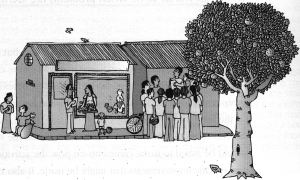
The Philippines MIS decided to monitor its system during monthly meetings attended by the facilitator, data collectors and other operators. Each person was asked to bring up any problems they had noticed during the month, and the whole group discussed possible solutions.
Among issues that arose were the following.
The Uganda MIS group chose an informal monitoring system, meeting with the facilitator whenever he came to the village.
Among the issues that arose during monitoring discussions were the following.
It may seem premature to think about the evaluation before the MIS is fully under way, but it is important to programme regular evaluations right from the start. Evaluations, along with regular monitoring, are critical to ensuring that the MIS is meeting the needs of the participants. Because the evaluation measures changes that take place as a result of the MIS, it can be helpful to collect data about users before the MIS is implemented. If, for example, the purpose of the MIS is to increase sales, information on the rate of sale before the project starts can be recorded. If the objective is to increase the price sellers receive, then data on what they are getting before the MIS starts will be useful when it comes time to evaluate changes in sales price. Much of this information is available from the assessment that was done in Step II.
As noted above, monitoring is a regular activity that focuses on the specific activities carried out in the MIS and any problems in implementing those activities. The evaluation takes a broader look. It starts by assessing whether the initial goals and objectives continue to make sense in relation to the needs of the users. Then it looks at whether the system that has been put in place is effective in meeting the goals and how it might be improved. It is also important to evaluate whether the system is progressing toward being locally sustainable. It will undoubtedly receive a certain amount of assistance in the beginning while the facilitator provides technical guidance, but the system should progressively move toward being independent.
At this stage in the design, the following issues should be discussed.
1. What kind of issues will be addressed in the evaluation?
2. What kind of information is needed as a baseline record of how things were before the project got started?
3. Who will do the evaluation?
4. When will the evaluations take place?
A decision should be made on when evaluations will be carried out. The first evaluation should be soon after the operation of the MIS is regularized, probably within the first six months. Thereafter, evaluation should take place at standard intervals, such as once a year.
The evaluation should be done by a team that includes those who work with the MIS and have been involved in its implementation, as well as those who have not had regular contact with the system. It is often useful to have at least one outsider on the team, such as an extension agent or a project official who is not from the village. They may notice things and add a perspective that local people will not have. The team should gather information from members of the MIS group, from users not in the group (if there are any) and from non-users who were given the opportunity to use the system but chose not to. It is important to include non-users because one purpose of the evaluation is to understand why people do or do not use the system and how (if this is one of the objectives) it might be expanded to a larger population. (This would not be relevant if the group has decided to make its MIS exclusive to the group.) Generally, the evaluation will try to assess who has (and has not) benefited from the MIS and what the nature/magnitude of the benefits have been to the users. Appendix 5 reviews some of the checklists and tools used in the Uganda and Philippines evaluations.
The issues included in an MIS evaluation will depend greatly on the nature of its objectives. The following list includes broad areas of interest that the evaluation system can assess.
Physical structure |
Level of awareness and frequency of use |
Utility and quality of the data |
Sustainability of the system |
Achievement of objectives and goals |
Is the system structured well to gathers process and disseminate information? |
Who is aware of the system and its purpose? |
Is the information accurate? Appropriate? |
Are there future financing prospects for the system? |
Has market transparency increased? |
Are the collectors doing their jobs? |
Who is using the information from the MIS and how often? |
Is enough information provided? |
Is there local enthusiasm for the MIS? |
Has awareness of and interest in marketing information increased? |
Is the equipment sufficient? |
How are they using the information? |
Is the information helpful? Relevant? |
Can/should the system be institutionalized? |
Is the information being used as intended? |
Was training of users, collectors and analysts adequate? |
Is the information timely enough in terms of users'needs, harvesting schedules, market days, product perishability? |
Are users more informed than non-users? | ||
Have profit margins and/or in come of users increased? |
Are users more informed than they were before implementation of the MIS? (Compare current knowledge to information gathered in Step II.) |
In the Philippines, the first MIS site was evaluated after four months. The evaluation assessed overall operation and management, areas for improvement and lessons that might help when applying the MIS to other sites. The evaluation team included the facilitator, an FAO consultant, representatives of the social forestry project in the area and members of the local farmers' association who had been involved in MIS design and implementation. The evaluation involved visits to farm households and a survey of the farmer/users and volunteer data collectors.
The evaluation first reviewed the goals and objectives of the MIS and considered feedback received during monthly meetings and through other informal mechanisms. The team developed a survey to determine how much participants' knowledge of the market had increased, their awareness of the system and their ideas for how the system could be improved.
The sample questions were first tested with the data collectors see Appendix 5 for the evaluation questionnaire that was used. The questionnaire was then administered to the data collectors, the record- keeper and members of the local population (including a cross section of people living both near and far from the road). The report from the evaluation outlined opportunities for improvement and expansion of the system.
A second evaluation was held the following year using more qualitative techniques such as Rapid Rural Appraisal. To determine, for example, whether the group was becoming less dependent on the facilitator, a matrix was used to compare the role each played in planning/design and implementation during different time periods. Participants divided 10 stones among the "group" and "facilitator" boxes to indicate which had played a more important role. From the example in Sta. Catalina (below), it is evident that the group felt it was taking an increasingly-important role, particularly in project design.
Group/Facilitator |
G |
F |
G |
F |
G |
F |
G |
F |
G |
F |
Planning/Design |
3 |
7 |
5 |
5 |
6 |
4 |
8 |
2 |
8 |
2 |
Implementation |
8 |
2 |
8 |
2 |
8 |
2 |
9 |
1 |
4 |
6 |
The purpose of the Uganda evaluation was to examine changes in market knowledge and transparency, and to assess the impact of the MIS on the users' business activities.
The evaluation took three and a half days in each village and employed a range of Rapid Rural Appraisal tools including semi-structured interviewing. For each semi-structured interview, a question guide was prepared to ensure that all the topics were covered (see the example in Appendix 5). A number of visual techniques were also used to help people express their opinions on the project.
To get information on participants' knowledge of market transparency, people were asked to draw the marketing chain for products included in the MIS. By comparing the diagrams to those that had been made during the assessment step of the MIS, it was easy to see how knowledge of the market had changed. The market chain diagrams of project participants also were compared to diagrams drawn by handicraft traders who were not part of the MIS. These techniques permitted both before/after comparisons and participant/nonparticipant comparisons.
To gather information about the benefits of the MIS, a list of possible benefits was compiled by group members. They then ranked those benefits in terms of how important they thought they were to their business and according to whether they felt the project had helped in delivering them.